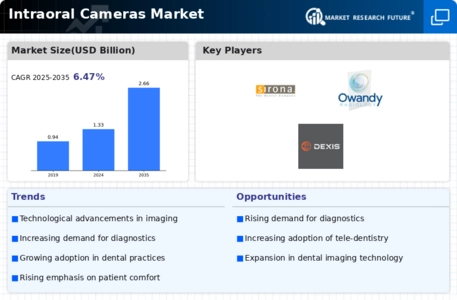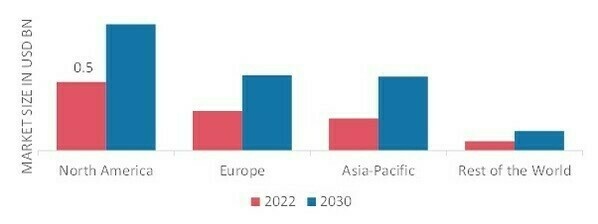Market Analysis
Intraoral Cameras Market (Global, 2024)
Introduction
The intraoral camera market is set to play a key role in the evolution of dental diagnostics and patient care, owing to the advancement of the technology of image and the increasing importance of preventive dentistry. These small, high-resolution devices enable dentists to capture high-quality images of the patient’s oral cavity, thus enabling improved communication with patients and more accurate treatment planning. As the demand for minimally invasive procedures rises, intraoral cameras are becoming indispensable tools in dental practices, enabling real-time visualisation and documentation of the patient’s oral health. In addition, the increasing integration of digital solutions and telehealth solutions is changing the landscape of dental care, making intraoral cameras not only valuable diagnostic tools but also a key element in the delivery of remote consultations and patient education. The growing awareness of the link between oral health and general health is also expected to boost the adoption of these devices, thereby propelling the intraoral camera market to new heights.
PESTLE Analysis
- Political
- In 2024, the regulatory framework for medical devices, including intraoral cameras, will be largely influenced by the FDA’s strict guidelines. Class IIb devices are those that require premarket approval. In 2024, there will be about 1,500 pending 510(k) applications for dental devices. The manufacturers will have to work within a robust regulatory framework. In addition, the U.S. government will allocate $50 million to dental health initiatives. These will indirectly influence the adoption of advanced dental devices like intraoral cameras.
- Economic
- In 2024, the economy shows an increase in the investment in dental technology, with dental practices spending on average $25,000 on new equipment, including intraoral cameras. The dental market in the United States alone is expected to reach $145 billion, indicating a high demand for innovative dental solutions. Furthermore, the unemployment rate in the health care industry is only 3.5%, which shows a stable workforce that supports the growth of dental practices and their ability to invest in advanced dental technology.
- Social
- In 2024, according to a survey, the American population was aware of the importance of dental health. Seventy percent of the adult population now values regular dental check-ups. The increased demand for preventive care is also reflected in the use of intraoral cameras, which facilitate patient education and participation. The aging of the population, with 20 percent of Americans over the age of 65 in 2025, is also expected to increase the need for advanced dental diagnostics and thus drive the market for intraoral cameras.
- Technological
- The recent developments in the field of intraoral cameras are considerable. We now have HD intraoral cameras that are able to capture images at a resolution of up to 1920 x 1080 pixels. In 2024, more than 60% of dental practices are expected to have installed digital imaging technology, including intraoral cameras, to improve the accuracy of diagnosis and the outcome of treatment. Artificial intelligence is also gaining ground, with some 15% of new intraoral camera models having been equipped with an AI system to assist with the detection of dental disease.
- Legal
- In 2024, compliance with HIPAA is still essential for dental practices using intraoral cameras, which often record confidential information about the patient. Approximately 80% of dental practices have reported that they have taken increased measures to protect patient data in keeping with their legal responsibilities. Further, the enactment of new data protection laws in some states may require dental practices to change the way they handle patient data from intraoral cameras.
- Environmental
- The impact of dental practices on the environment is being increasingly studied, and the concept of sustainable dentistry is increasingly being taken into account. By 2024, it is estimated that one third of dental practices will have adopted eco-friendly practices, such as the use of digital images and intraoral cameras, which replaces the use of film and chemicals. Also, the dental industry is expected to reduce its carbon footprint by 10 per cent over the next five years, largely as a result of initiatives to reduce waste and promote the use of sustainable materials in dental equipment.
Porter's Five Forces
- Threat of New Entrants
- The market for intraoral cameras is characterized by medium barriers to entry, as a result of significant investment in technology and research and development. Brand recognition and customer loyalty are strong among the leading companies, which may deter new entrants. However, the increasing demand for dental imaging solutions and the technological developments that will result from this will attract companies seeking to offer innovations.
- Bargaining Power of Suppliers
- The bargaining power of suppliers in the intraoral camera market is relatively low. There are a large number of suppliers of components and materials used in the production of intraoral cameras, which reduces the dependence of a single supplier. This abundance of suppliers allows the manufacturers to negotiate better prices and terms, which increases the power of companies in the market.
- Bargaining Power of Buyers
- The buyers of intraoral cameras, mainly dental offices and clinics, have a high bargaining power because of the availability of many alternatives. If a better price or a better product is found elsewhere, the buyers are in a position to change suppliers. Therefore, the companies have to offer the best price and the best quality to remain in the market.
- Threat of Substitutes
- The threat of substitutes in the intraoral camera market is moderate. As a specialized tool for dental photography, intraoral cameras can be substituted by X-rays and other diagnostic devices. The advantages of intraoral cameras in terms of immediate viewing and patient communication are unique.
- Competitive Rivalry
- The market for intraoral cameras is highly competitive, with a large number of established players and new entrants vying for market share. Product differentiation is important to companies, and they compete to develop the best products. This results in aggressive marketing and price competition. The growing demand for dental imaging solutions and rapid technological developments further intensify competition.
SWOT Analysis
Strengths
- High demand for advanced dental diagnostic tools.
- Improved patient experience through enhanced visualization.
- Integration with digital dentistry and telehealth solutions.
- Increased accuracy in diagnosis and treatment planning.
Weaknesses
- High initial investment costs for dental practices.
- Need for training and adaptation among dental professionals.
- Potential technical issues and maintenance requirements.
- Limited awareness among some patient demographics.
Opportunities
- Growing trend of preventive dental care.
- Expansion into emerging markets with increasing dental health awareness.
- Technological advancements leading to more compact and affordable devices.
- Partnerships with dental software companies for integrated solutions.
Threats
- Intense competition from established dental equipment manufacturers.
- Rapid technological changes leading to obsolescence.
- Economic downturns affecting dental spending.
- Regulatory challenges and compliance issues in different regions.
Summary
The Intraoral Cameras Market 2024 is characterized by strong demand for advanced diagnostic tools and improved patient experience. The high initial costs and the need for training are a challenge. Opportunities are the growing focus on prevention and technological development. Threats are the high level of competition and the economic consequences. Strategic alliances and market expansion could increase growth prospects.







Leave a Comment